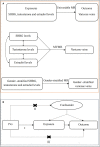Sex hormone-binding globulin exerts sex-related causal effects on lower extremity varicose veins: evidence from gender-stratified Mendelian randomization
- PMID: 38152135
- PMCID: PMC10752419
- DOI: 10.3389/fendo.2023.1230955
Sex hormone-binding globulin exerts sex-related causal effects on lower extremity varicose veins: evidence from gender-stratified Mendelian randomization
Abstract
Background: The association between serum sex hormones and lower extremity varicose veins has been reported in observational studies. However, it is unclear whether the association reflects a causal relationship. Besides, serum sex hormone-binding globulin (SHBG) has been rarely studied in lower extremity varicose veins. Here, we aim to investigate the association between serum levels of SHBG, testosterone, and estradiol and the risk of lower extremity varicose veins using Mendelian randomization (MR).
Methods: We obtained genome-wide association study summary statistics for serum SHBG levels with 369,002 European participants, serum testosterone levels with 424,907 European participants, serum estradiol levels with 361,194 European participants, and lower extremity varicose veins with 207,055 European participants. First, a univariable MR was performed to identify the causality from SHBG and sex hormone levels to lower extremity varicose veins with several sensitivity analyses being performed. Then, a multivariable MR (MVMR) was performed to further assess whether the causal effects were independent. Finally, we performed a gender-stratified MR to understand the role of genders on lower extremity varicose veins.
Results: Genetically predicted higher serum SHBG levels significantly increased the risk of lower extremity varicose veins in the univariable MR analysis (OR=1.39; 95% CI: 1.13-1.70; P=1.58×10-3). Sensitivity analyses and MVMR (OR=1.50; 95% CI:1.13-1.99; P=5.61×10-3) verified the robustness of the causal relationships. Gender-stratified MR revealed that higher serum SHBG levels were associated with lower extremity varicose veins in both sexes. However, the OR of serum SHBG levels on lower extremity varicose veins risk in females (OR=1.51; 95% CI: 1.23-1.87; P=1.00×10-4) was greater than in males (OR=1.26; 95% CI: 1.04-1.54; P=1.86×10-2).
Conclusions: Serum SHBG levels are positively related to lower extremity varicose veins risk in both sexes, especially in females. This may partly explain the higher prevalence of varicose vines among females.
Keywords: gender-stratified Mendelian randomization; lower extremity varicose veins; sex difference; sex hormone; sex hormone-binding globulin.
Copyright © 2023 Fan, Meng, Nie, Xie and Chen.
Conflict of interest statement
The authors declare that the research was conducted in the absence of any commercial or financial relationships that could be construed as a potential conflict of interest.
Figures




Similar articles
-
Genetically predicted sex hormone levels and health outcomes: phenome-wide Mendelian randomization investigation.Int J Epidemiol. 2022 Dec 13;51(6):1931-1942. doi: 10.1093/ije/dyac036. Int J Epidemiol. 2022. PMID: 35218343 Free PMC article.
-
Associations between sex hormones, receptors, binding proteins and inflammatory bowel disease: a Mendelian randomization study.Front Endocrinol (Lausanne). 2024 Apr 10;15:1272746. doi: 10.3389/fendo.2024.1272746. eCollection 2024. Front Endocrinol (Lausanne). 2024. PMID: 38660517 Free PMC article.
-
Exploring Causal Relationships between Leukocyte Telomere Length, Sex Hormone-Binding Globulin Levels, and Osteoporosis Using Univariable and Multivariable Mendelian Randomization.Orthop Surg. 2024 Feb;16(2):320-328. doi: 10.1111/os.13947. Epub 2023 Dec 12. Orthop Surg. 2024. PMID: 38084376 Free PMC article.
-
Associations of Sex Steroids and Sex Hormone-Binding Globulin with Non-Alcoholic Fatty Liver Disease: A Population-Based Study and Meta-Analysis.Genes (Basel). 2022 May 27;13(6):966. doi: 10.3390/genes13060966. Genes (Basel). 2022. PMID: 35741728 Free PMC article.
-
Sex hormone-binding globulin: biomarker and hepatokine?Trends Endocrinol Metab. 2021 Aug;32(8):544-553. doi: 10.1016/j.tem.2021.05.002. Epub 2021 May 26. Trends Endocrinol Metab. 2021. PMID: 34052096 Review.
Cited by
-
Systemic exogenous progestins with or without estrogens are associated with decreased rates of venous procedures for varicose veins.J Vasc Surg Venous Lymphat Disord. 2025 Jul;13(4):102235. doi: 10.1016/j.jvsv.2025.102235. Epub 2025 Mar 20. J Vasc Surg Venous Lymphat Disord. 2025. PMID: 40120674 Free PMC article.
-
Circulating inflammatory cytokines and colorectal cancer: New insights from Mendelian randomization.Medicine (Baltimore). 2025 Jan 24;104(4):e41331. doi: 10.1097/MD.0000000000041331. Medicine (Baltimore). 2025. PMID: 39854755 Free PMC article.
References
Publication types
MeSH terms
Substances
LinkOut - more resources
Full Text Sources
Medical
Miscellaneous

